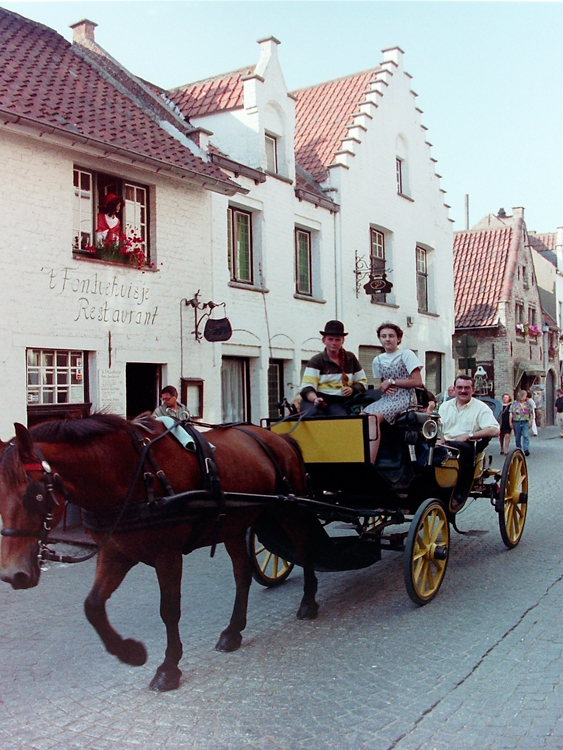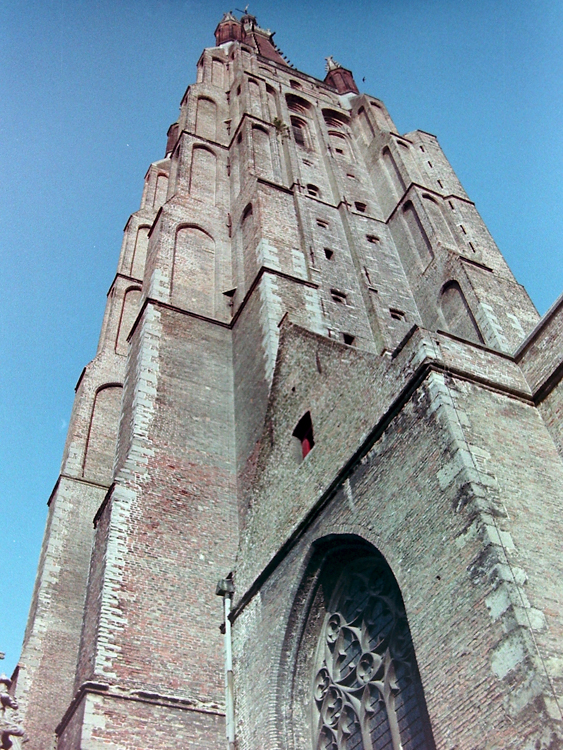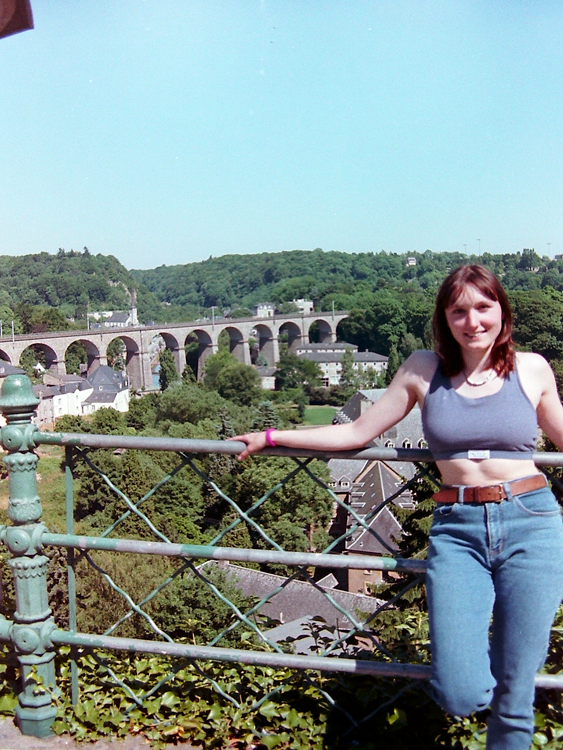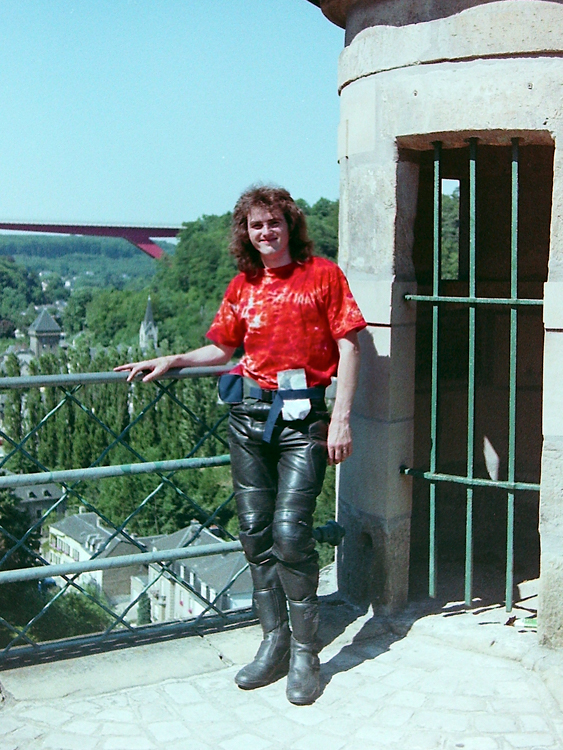A Breakdown in Belgium
We rolled off the boat at Calais into a beautiful sunny morning, and instantly turned northward intending a late breakfast in Brugge. However, the 130kph E40 soon got boring, so we turned off to take the parallel the coast road through De Panne and Nieuwpoort. At first it seemed like a good idea, and a much better way of starting a tour than hammering up the motorway. Even though the Belgian polders were as flat as ever, at least there were interesting dykes and canals to look at, and I was just congratulating myself on another successful long cut when we suddenly ran into Grockleville B.V., packed wall to wall with cars carrying tourists to enjoy a day sandwiched on the beach.
Rather than struggle up the beach zone, we turned back toward the E40, but almost immediately Lisa’s CBR dwindled in my rear-view mirrors and rolled to a stop by the roadside. Only one of the four cylinders was firing, which didn’t provide enough power to ride, so after checking for the usual faults I left Lisa with her bike and went off to find help. First I met a policeman, who directed me to an Audi garage, who directed me to a bicycle shop in Nieuwpoort, who directed me to a Honda dealer in Veurne. Miraculously, this shop was still open on a Saturday afternoon, but their tow-truck was ‘en panne’.
They were talking about ringing around some friends to see if they could find anybody with a trailer, but instead I borrowed a tow-rope and went back to the CBR, where Lisa was getting happily sunburnt by the roadside. My TDM towed her CBR without any problems, and the hard shoulder was wide and clear so we didn’t have to worry about traffic.
A few miles up the road, a police van did a U-turn to check us out, but they couldn’t work out whether what we were doing was illegal or not so, realising that we probably knew more about what we were doing than they did, they left us to it.
Fifteen minutes later we were installed in the bike shop in Veurne, where the nice man soon spotted that the fuel pump had failed. He didn’t have any new ones in stock, but he did have a lot of customers bikes in for repair, and we spent a merry time poking around in a load of crash-damaged frames looking for something that would fit. None of the CBRs had the right pump, and one off a Revere was the right design but had far smaller bores which suggested that we wouldn’t get a high enough flow rate for the CBR. Not to be defeated, the salesman opened up the showroom and pulled the pump out of a brand new Transalp that was standing in the window. A few minutes later, we were off.
Finally we rolled into the Brugge campsite, had a much-needed beer, and then set out on foot to have a look at the city. It is an attractive town, packed with narrow streets lined with gable-ended houses, and dominated by the clop-clop of horse-driven taxis and by the huge cathedral in the centre. The cathedral did not seem to be open to the public, but from the outside it had a vast presence, sprawling over a surprisingly wide area, an imposing brick-built edifice reminiscent of the monastery in ‘The Name of the Rose’. We sat in its shadow in a terrace cafe and ate an expensive but excellent dinner of ‘kroketten’, ‘moules’, and a local dish made from a mixture of fish in a creamy spinach sauce. All, of course, washed down with lashings of Belgian beer.
Crop Circles
The following day, after a leisurely start, we whipped around the Brussels ring-road and then, rather than stay on the boring motorway, took the quieter N4 toward Luxembourg. It was another beautiful day, and at a petrol stop we spent our few remaining francs on chocolate milkshakes and sat at the side of a cornfield to drink them. The corn had been recently cut, and the hay was lying in golden rows under the blazing sun. We sat and admired the scene, and then something strange started happening in the air in front of us. and swiftly a little dust-devil built itself up into a straw-filled whirlwind some twenty feet high. It had a footprint about four feet in diameter and acted like a big hoover, sucking up circles of hay and then moving on with the stalks whirling around inside the cone. It bumbled around the field at walking pace for a while, pausing now and again to leave mysterious crop circles in its wake, before heading up the bank onto the main road. A car passed through it without any noticeable effect, and then it was across the road and into some shrubbery, where it dropped its load of hay but we could still make out its progress by the swaying of the bushes on this otherwise still day.
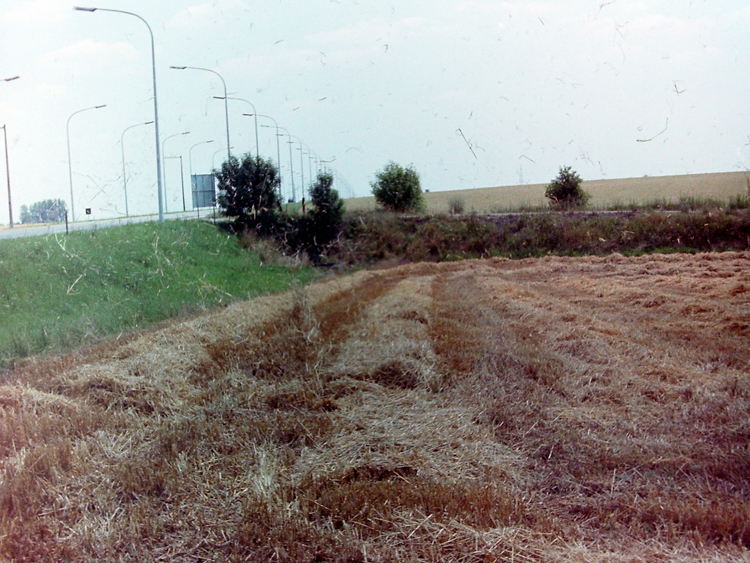
Crop circle in the making
Bemused, we got back onto the road, and for a while enjoyed a leisurely ride past the little high-gabled houses that formed the occasional village, punctuating the long flat plains of cabbages and potatoes that stretched to the flat horizon. Soon, however, the road degenerated into just another motorway, and I was glad when we were overtaken by a dozen Belgian bikers out on a run. They were really tanking it, but I snuck in behind the rear machine and we stayed with them all the way to Luxembourg.
Luxembourg
As soon as we crossed the border, the nature of the countryside altered dramatically from flat crop land to tree-lined hillsides. About 25 miles from the city we turned off down a random side road, sat on a bridge for a while watching damselflies, and then drove along the small hilly lanes until we found a small camp site.
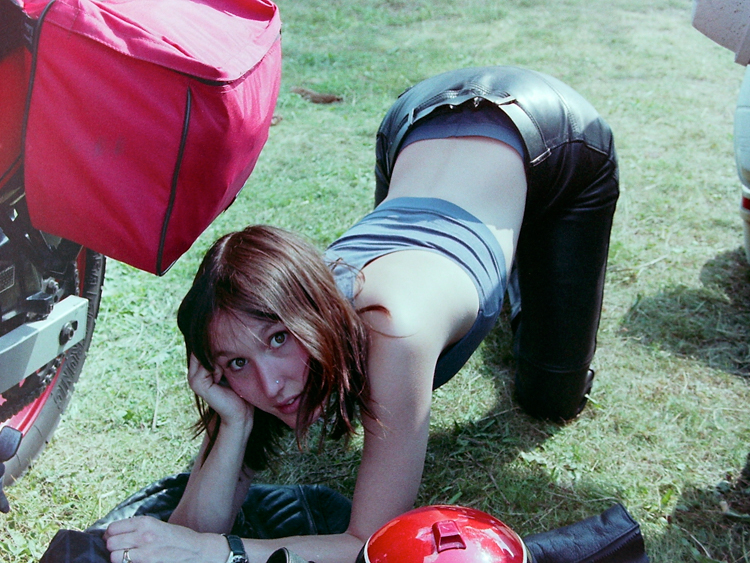
Checking the chain lube
It was a tree-lined field with no visible signs of authority, but some French campers told us to pitch up and then go to a certain house in the village at 18:30 to book in. A kindly elderly lady in a small house stuffed with antiques accepted a small amount of French francs in lieu of the Belgian ones that we didn’t have, and told us that although there weren’t any restaurants locally, tonight was the night of the local village fete and we might be able to pick up something to eat there. We were starving, so we made our way up to the tented area where everybody seemed to be having a fun time, although we felt very much like outsiders intruding on somebody’s private party. Nevertheless, we stood and drooled by a family-run hot-dog stand while they animatedly discussed exactly how much ten French francs was in Belgian currency, which was all pretty academic as all we had were ten-franc pieces and we’d have happily given away everything we had for a chance at those succulent sausages.
Finally everybody was happy, and we were ceremoniously presented with our food, which we wolfed hurriedly while debating going through the whole thing again at the beer stand. Cowardice prevailed, and we returned to our bikes to see if we could find a restaurant that accepted Visa. A few miles up the road was ‘Le Martin Pecheur’, dominated by an impressive stained-glass window of its namesake, where we washed down an excellent meal with a terrific Mosel wine, very tasty and a far cry indeed from the sugar water sold to teenage girls in England.
Feeling that our wine trip had now truly begun, we finished off with an interesting variation on Liqueur Coffee, with the coffee sandwiched between a layer of cream above and a clear layer of spirit below, served in a tall glass and drunk through a straw. Very potent.
Luxembourg City
Another late start, a leisurely coffee, another beautiful morning. A gorgeous run through rolling forested hills dotted with small sculpted villages and friendly people, ending in the fantastic city of Luxembourg itself.

Luxembourg city centre
Based around an AD 693 fortress almost surrounded by a deep hairpin chasm, the city is intermingled with rich parkland and vertical cliffs. Many of the buildings are impressively spired, most are intricately moulded. Walking along the old fortress wall, we discovered the Bock Casements, the remnants of the original castle which was voluntarily destroyed by the city itself in an attempt to establish their neutrality. They had comprehensively razed the castle itself, but there wasn’t much they could do about the subterranean tunnels, so they just blocked them off. Now they were open to the public, and stuffed full of history.
During the last war, 35,000 people sheltered during air-raids, and prior to that many of the caverns had been used for imprisoning this or that Duke, or provided a home for this or that exiled monarch. Most of the main tunnels were sign-posted, but many were not only unsigned but also unlit, and with a torch you could meander deep underground. In fact, the whole underside of the city is riddled with tunnels, and it is easy to see how it gets its name of The Gibraltar of the North. We completed our circuit of the city wall, grabbed some supplies from a handy supermarket, and headed for Germany, the Mosel Valley, and the start of our holiday proper.
The Mosel Valley
Suddenly we had arrived, and were confronted with more grape vines than I had ever seen in my life. My first impression was of the sheer mono-crop dedication that characterises Spanish olive groves. My second was that all the camp sites were heavily commercial and packed with caravans. Camping areas must be at a premium where every other square inch of land, even down to the roadside verges, is cultivated with grape vines. However, along a quieter stretch of road and a little away from the river itself we came across a little camp site that consisted of a small field ringed with permanent caravans. No sooner had we set up the tent when strings of people wandered up and introduced themselves, tut-tutting at our equipment and lending us tables and chairs, until very shortly we got involved in a Mosel wine-drinking session from the camp site’s own cellars. The world seemed to be entirely populated with friendly fat retired Germans slowly drinking the summer nights away, and as the sun set into the haze over the vineyards, I reflected that there was very little wrong with that.
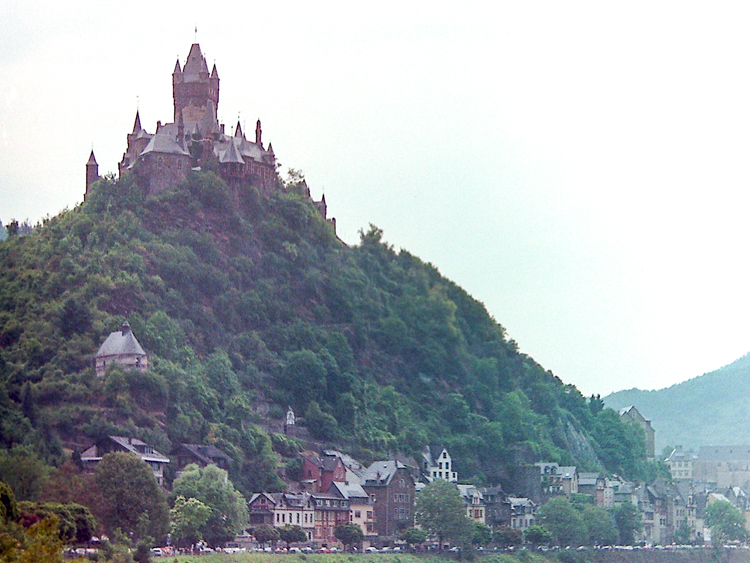
The Mosel Valley is littered with castles
The next morning we returned all the furniture, said our goodbyes, and headed off once more into the sunshine. The villages and towns along the Mosel valley were a riot of colour, skilfully painted and gilded and carved and hung about with flower boxes stuffed with colourful blooms. In Traban Trarbach a storm blew up out of nowhere and we sheltered under a bridge until the worst of it had passed. The rest of the afternoon was duller weather-wise, but geographically beautiful. The storm appeared to be trapped in the valley, but the villages continued to be picturesque, linear populations facing each other across the broad expanse of the river, dotted with far more thin-steepled and onion-towered churches than can possibly be required, and backed by a quilted patchwork of vineyards studded with religious shrines, huge rock sundials, and hundreds of tiny figures lovingly tending the vines.
Eventually we entered Koblenz, and headed into the city intent on finding the confluence of the Mosel and the Rhine. We found it at a place called Deutsches Ecke, parked up and caught the sightseeing boat. The trip took an hour and travelled up each of the three arms of the t-shape where the rivers meet, surprisingly placidly, at a monument to the Kaiser. I say surprisingly, because the Rhine was flowing very fast indeed. The bow waves of the ubiquitous hundreds-of-feet-long Rhine barges threatened continually to swamp them as they forged their way upstream, and those coming downstream were greased lightning. These barges were immense, carrying all sorts of cargoes including coal, scrap metal and petroleum products, and sported mobile-home sized living accommodation fore and aft, with enough parking on board for a couple of cars too.
The Mosel had been occasionally punctuated by immense river locks for these craft, and often while one was coming through there would be another holding perfect station against the current below, waiting patiently for its turn, surrounded by a myriad tiny pleasure cruisers struggling against the fierce current, trying to stay close enough to nip in after the colossus when the locks opened.
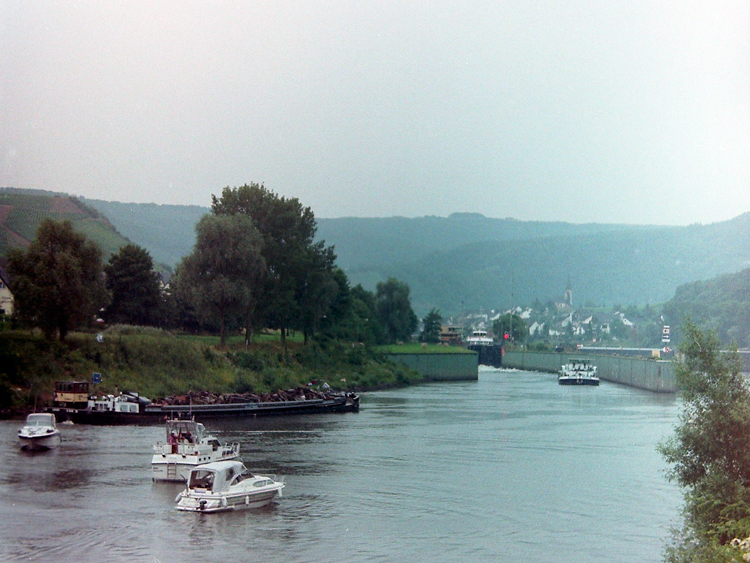
Waiting for the lock
The Rhine Valley
Once more on dry land, we were presented with a choice of two B-roads, one on either side, that headed south with the river. The B42 on the eastern bank ran through national parkland, so on the grounds that it might be less busy we took the western B9. The heavy traffic had become a bit of an issue for us, as even in the countryside it felt like we were driving through town, and as a side-effect it meant that the camp sites were literally packed tent-to-tent and caravan-to-caravan, not to mention satellite-dish-to-satellite-dish. So far, by judicious choice, we had been lucky with camp sites, and we wanted to keep it that way. The Rhine valley south of Koblenz sprouted more castles than we could shake a stick at, most of them apparently occupied, and although many of them were splendidly photogenic the roads were too narrow and busy to stop.
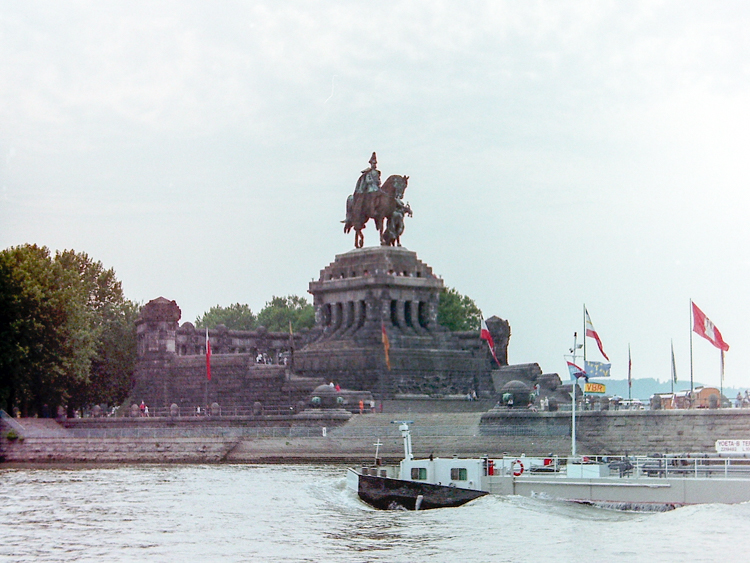
Deutsches Eck, where the Mosel meets the Rhein
We only rode a short distance, just far enough to get fully clear of Koblenz, and then started looking for camp site signs that pointed away from, rather than toward the popular riverside locations, on the basis that these would probably be smaller and quieter. We ended up on a tiny strip of grass hacked out of a forested gully, with a little restaurant bar at one end. After a good meal, some beer, a walk in the woods and some more of yesterdays Mosel wine, we went to bed.
After a preprandial coffee at the camp site, we had a light breakfast in the picturesque town of St Goar, before continuing up the Rhine valley as far as Bingen. Here you enter the huge industrial complex of Mainz, Frankfurt, Darmstadt, Ludwigshafen and Mannheim, so we cheated and took the motorway to Heidelberg. Although it strictly isn’t in the Rhine valley at all, I had always wanted to go there and this seemed like a good excuse.
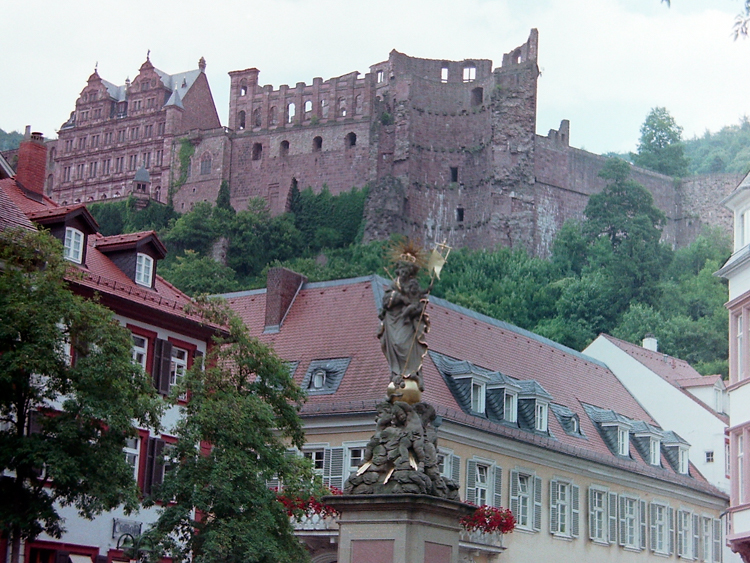
Heidelberg Castle
The old town was pretty enough, and after lunch we set off up the hill to see the castle. This proved to be particularly impressive, all pink stone, heraldic emblems and gilding, and had obviously been extensively restored, with work continuing apace. In the Great Hall beneath the castle were two enormous wine barrels, called Klein and Gross Fass; the latter at 220,000 litres is allegedly the biggest in the world. Certainly it is the only barrel that I have ever seen with steps leading up to a balcony on top, on which you could hold a fair-sized dinner party. We supped a commemorative glass of Heidelberg wine, and then hit the road for the Black Forest.

Kleine Fass is the smaller of the two great barrels in Heidelberg Castle
